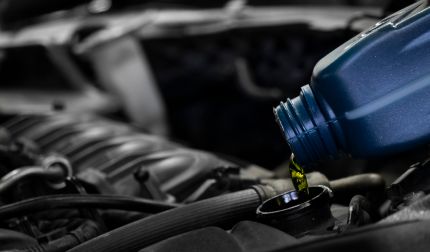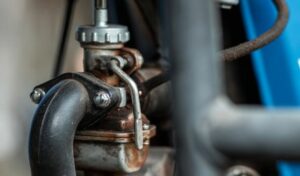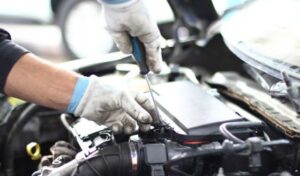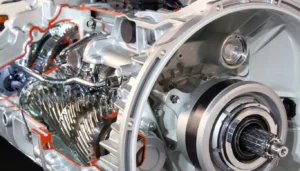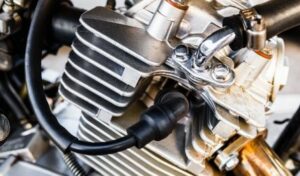Lubricating, reducing friction, and dissipating heat, engine oil is your car’s lifeblood. Your engine would overheat and be severely damaged without oil. However, if your car is burning oil, you must find the cause and fix it immediately to avoid further issues and maximise performance.
Burning oil is a common problem that can cause fuel efficiency loss, increased emissions, and engine failure if left unchecked. Blue or grey exhaust smoke, an oil smell in the cabin, or a drop in oil levels without visible leaks are signs of oil burning. These signs should be monitored and addressed before they worsen.
This article will discuss car oil burning causes, diagnose the problem, and offer solutions. We’ll also discuss oil burning prevention. Understanding the causes and solutions can keep your car’s engine running smoothly for years.
Importance of oil in an engine
Your car’s engine needs oil. Engine oil reduces friction, wear, heat, and impurities. Oil maintenance extends engine life, prevents failures, and improves fuel economy. Maintaining engine oil protects your car’s engine and ensures a reliable, high-performance drive.
Oil-burning issues
Burning oil can damage your car’s performance, longevity, and health. We’ll discuss oil burning issues next.
Reduced fuel efficiency, higher emissions, engine wear, oil performance, and catalytic converter damage.
Addressing oil burning issues prevents these issues and maintains your engine. Fixing oil burning can prevent engine failure, performance issues, and expensive repairs.
Signs of oil burning
Recognizing the signs of oil burning is crucial for addressing the issue before it leads to severe problems and costly repairs. By keeping an eye out for these indicators, you can take prompt action to diagnose and resolve the underlying causes, ensuring your car’s engine remains in optimal condition.
Blue or gray smoke from the exhaust, an oily smell inside the cabin, decreased oil levels, excessive oil consumption, fouled spark plugs, poor engine performance, and the check engine light are the most common signs of oil burning.
5 Causes of oil Burning in A Car
Worn piston rings, damaged valve seals, a malfunctioning Positive Crankcase Ventilation (PCV) system, excessive engine wear, and using the wrong oil grade can cause oil burning in a car. Oil can enter the combustion chamber through worn piston rings and valve seals and burn, producing smoke.
The intake manifold can burn oil if the PCV system fails. Using the wrong oil grade or excessive engine wear can cause oil to break down faster and burn. Identifying your car’s oil burning cause is crucial to fixing it and maximising engine performance.
1. Worn piston rings
Worn piston rings cause engine oil burning. Piston rings seal the piston-cylinder wall gap with circular metal bands. They maintain combustion chamber compression, prevent combustion gases from escaping, and control cylinder wall oiling.
Normal engine operation, high mileage, or poor maintenance can wear piston rings. Oil leaks into the combustion chamber as rings wear. Oil burns with the air-fuel mixture in the combustion chamber, producing blue or grey smoke. Worn piston rings reduce compression, reducing engine power, fuel efficiency, and idling.
Worn piston rings cause oil consumption, exhaust smoke, fouled spark plugs, and poor engine performance. A professional mechanic should inspect and repair your car if you suspect worn piston rings are causing oil burning. Fixing this issue quickly can prevent engine damage and keep your car running well.
Symptoms of worn piston rings
Worn piston rings can reduce engine performance. These symptoms can help you fix the problem before it worsens. Worn piston rings can cause excessive oil consumption, engine misfires or rough idling, low compression, oil in the combustion chamber, and low performance.
If you notice any of these symptoms, see a mechanic for a full inspection and repairs. Repairing worn piston rings quickly can prevent engine damage and keep your car running well.
2. Damaged valve seals
Engine oil burning is also caused by damaged valve seals. Cylinder head valve seals are small, rubber-like components around valve stems. They prevent oil from entering the combustion chamber.
High mileage, temperature, and neglect can wear and break valve seals. They can no longer prevent oil from entering the combustion chamber. Oil can leak past the broken seals and enter the combustion chamber, where it burns with air and fuel. Oil consumption and exhaust blue or grey smoke increase.
Damaged valve seals cause exhaust smoke, especially during startup or idling, excessive oil consumption, and spark plug fouling. A professional mechanic should inspect and repair damaged valve seals if you think your car is burning oil. Repairing damaged valve seals quickly can prevent engine damage and optimise performance.
Symptoms of damaged valve seals
Common symptoms of damaged valve seals include:
Visible exhaust smoke, excessive oil consumption, fouled spark plugs, poor engine performance, and engine misfires or rough idling.
A professional mechanic should be consulted for a full check and any necessary repairs if any of these signs are present. Addressing damaged valve seals promptly can help prevent further engine damage and ensure your car continues to run efficiently.
3. PCV system malfunction
A faulty Positive Crankcase Ventilation (PCV) system can also cause engine oil burning. The engine crankcase’s PCV system removes harmful gases. They are recirculated into the intake manifold and burned in the combustion chamber. This reduces emissions and optimises engine performance.
The PCV system can malfunction and burn oil. Clogged PCV valves, damaged hoses, and other system issues can cause a malfunction. When the PCV system fails, crankcase pressure can force oil past piston rings and valve seals into the combustion chamber. Oil burns with the air-fuel mixture in the combustion chamber, increasing oil consumption and smoke.
Signs of a PCV system issue
Excessive Oil Consumption, Visible Exhaust Smoke, Poor Engine Performance, Increased Emissions, and Oil Leaks are PCV system problems.
A professional mechanic should inspect and repair your car’s PCV system if you suspect it’s burning oil. Fixing PCV system issues quickly can prevent engine damage and optimise engine performance.
4. Excessive engine wear
Cars suffer engine wear. It greatly affects engine performance, efficiency, and durability. High mileage, neglect, harsh driving conditions, and poor lubricants cause this wear. Engine wear causes oil burning, poor performance, and costly repairs.
Cylinder walls, piston rings, and valve seals degrade. Worn piston rings let oil burn with the air-fuel mixture. Oil burning issues can result from valve seal damage.
Compression decreases with engine wear, lowering performance, power, and fuel efficiency. Worn engine components cause noise, vibrations, and failure if ignored.
Follow your vehicle’s maintenance routine, including frequent oil changes, high-quality lubricants, and immediate performance issues, to prevent excessive engine wear and related issues. Engines last longer with regular maintenance.
Engine wear causes increased oil consumption, blue or grey exhaust smoke, decreased engine performance, poor fuel efficiency, engine noise and vibrations, low compression, engine misfires, and rough idling.
If these signs appear, see a mechanic. Avoid engine damage by addressing excessive engine wear quickly.
5. Incorrect oil grade
Incorrect engine oil grades can cause oil burning and other performance issues. Manufacturers recommend oil viscosity for each engine to optimise lubrication and protection.
Thin oil grades can pass through engine seals and piston rings, causing oil burning in the combustion chamber. Increased oil consumption, exhaust smoke, and engine performance can result.
However, thick oil may hinder oil flow and lubrication of critical engine components. This increases friction, accelerates engine wear, and decreases fuel efficiency.
Follow your vehicle’s manufacturer-recommended oil viscosity to avoid oil burning and other issues. For optimal engine performance and longevity, consult your owner’s manual or a professional mechanic for the right oil type and grade.
How To Diagnose the Cause of Oil Burning?
Diagnosing the cause of oil burning involves a systematic approach to inspecting various engine components and systems.
Root cause identification: Make that the owner’s manual’s suggested oil level and grade are used.
Examine the PCV valve and hoses for blockages, damage, or malfunction, which can cause excessive crankcase pressure and oil burning.
Perform a compression test to identify issues with piston rings, cylinder walls, or valve seals that may lead to oil burning.
Look for visible signs of oil leaks around the engine, such as from valve cover gaskets or oil seals, which can indicate worn or damaged components.
If the issue persists, consult a professional mechanic for a thorough inspection and diagnosis of potential underlying causes, such as damaged valve seals or worn piston rings.
1. Performing a compression test
A compression test is a diagnostic tool used to measure the pressure generated by each cylinder in an internal combustion engine. It helps to identify issues with piston rings, cylinder walls, or valve seals that may contribute to oil burning or other performance problems. To perform a compression test, follow these steps:
- Run the engine until it reaches its normal operating temperature.
- Disconnect the ignition coil or disable the fuel system to prevent the engine from starting during the test.
- Remove all spark plugs to ensure easier engine cranking.
- Screw the compression gauge into the spark plug hole of the cylinder being tested.
- Have an assistant crank the engine for a few seconds while you observe the compression gauge.
- Note the maximum compression reading for each cylinder.
- Compare the readings to the manufacturer’s specifications. A significant difference between cylinders or low readings may indicate issues with piston rings, cylinder walls, or valve seals.
If you suspect issues with your engine’s compression, consult a professional mechanic for further assessment and necessary repairs.
2. Inspecting the PCV system
Inspecting the Positive Crankcase Ventilation (PCV) system is crucial for diagnosing issues that may lead to oil burning or other engine performance problems. To inspect the PCV system, follow these steps:
- Refer to your owner’s manual or search online for the PCV valve’s location in your specific vehicle model.
- Inspect the hoses connected to the PCV valve for any cracks, damage, or blockages that could disrupt the system’s function.
- Remove the PCV valve and shake it gently. You should hear a rattling sound, indicating the valve is functioning correctly. Replace the valve if it’s jammed or clogged.
- With the engine running, place your finger over the valve opening. You should feel a vacuum, signifying proper operation. The valve or system may be clogged if not.
If any issues are found during the inspection, replace the damaged or malfunctioning components.
If you are unsure about any steps in the inspection process or need further assistance, consult a professional mechanic for help.
3. Examining the spark plugs
Examining the spark plugs can provide valuable insights into your engine’s health, including oil burning or other performance issues.
Check spark plugs: Find your vehicle’s spark plugs in the owner’s handbook or online.
Disconnect the spark plug wires or ignition coils and use a spark plug socket and ratchet to carefully remove each spark plug.
Examine the spark plug electrodes for signs of wear, damage, or fouling. Oil-fouled spark plugs will have a wet, oily appearance, which may indicate oil burning issues.
A healthy spark plug typically has a light brown or grayish-tan color. Black, oily deposits could signify oil burning, while white, ashy deposits may indicate a lean fuel mixture or overheating.
Use a spark plug gap tool to check if the gap between the electrodes is within the manufacturer’s recommended range.
Replace spark plugs if problems are found.
Reinstall the spark plugs and reconnect the spark plug wires or ignition coils. If you need further assistance or are unsure about any steps, consult a professional mechanic for help.
4. Consulting a professional mechanic
Consulting a professional mechanic is essential when dealing with complex engine issues, such as oil burning or performance problems. A skilled mechanic can diagnose and repair your car quickly and accurately. To consult a mechanic, follow these steps:
Look for reputable local mechanics or auto repair shops with positive reviews and experience in diagnosing and repairing similar issues.
Contact the chosen mechanic or repair shop to schedule an appointment for a diagnostic check and repair.
Clearly explain the symptoms and concerns you have about your vehicle to help the mechanic understand the problem better.
Once the mechanic has diagnosed the issue, they will provide a quote for the required repairs. Review the quote, ask questions if needed, and authorize the repairs.
Establish a relationship with a trusted mechanic and follow a regular maintenance schedule to prevent future issues and ensure your vehicle’s optimal performance and longevity.
Solutions For oil Burning
To address oil burning, identify the root cause and take appropriate action, which may include: using the correct oil grade, replacing worn piston rings or damaged valve seals, fixing PCV system malfunctions, and addressing excessive engine wear. Regular maintenance, timely repairs, and following manufacturer recommendations can prevent oil burning issues and ensure optimal engine performance.
1. Repairing or replacing worn piston rings
Repairing or replacing worn piston rings is crucial for resolving oil burning issues and restoring engine performance. To repair or replace worn piston rings, follow these steps:
Confirm worn piston rings as the cause of oil burning through a compression test or by consulting a professional mechanic.
Safely remove necessary engine components to access the pistons and rings. This task requires mechanical expertise and may be best left to a professional.
Remove the worn piston rings and install new ones, ensuring they are of the correct size and type for your vehicle.
Carefully reassemble the engine, replacing any damaged or worn parts encountered during disassembly.
Start the engine and monitor its performance to confirm the oil burning issue has been resolved.
A skilled technician should handle this repair due to its complexity.
2. Replacing damaged valve seals
Replacing damaged valve seals is essential for addressing oil burning issues and restoring engine performance. To replace damaged valve seals, follow these steps:
Consult a professional mechanic to confirm that damaged valve seals are the cause of oil burning.
Safely remove necessary components, including the cylinder head, to access the valve seals. This task requires mechanical expertise and may be best left to a professional.
Remove the damaged valve seals and install new ones, ensuring they are compatible with your vehicle’s specifications.
Carefully reassemble the engine, replacing any other worn or damaged components encountered during disassembly.
Start the engine and monitor its performance to verify that the oil burning issue has been resolved.
This repair is complicated, thus a professional technician should do it.
3. Fixing the PCV system
Fixing the PCV (Positive Crankcase Ventilation) system is essential to resolve oil burning issues and maintain optimal engine performance. To fix the PCV system, follow these steps:
- Check the PCV valve and hoses for damage, blockages, or malfunction as mentioned in previous answers.
- If the PCV valve is found to be malfunctioning, clogged, or stuck, replace it with a new valve that is compatible with your vehicle.
- If you find any cracked or damaged hoses during the inspection, replace them with new hoses of the correct size and type.
- If you discover any blockages in the PCV system, such as in the hoses or the valve itself, carefully remove and clean them to ensure proper ventilation.
- After making the necessary repairs, start the engine and verify that the PCV system is functioning correctly by checking for vacuum at the PCV valve and observing improvements in the engine’s performance.
If you are unsure about any steps in the repair process or need further assistance, consult a professional mechanic to help fix the PCV system and resolve oil burning issues.
Conclusion
Worn piston rings, damaged valve seals, PCV system malfunctions, excessive engine wear, or using the wrong oil grade can cause oil burning in a car. Restoring engine performance and preventing further damage requires finding the root cause. Regular oil changes, high-quality engine oil, engine warming, and oil level monitoring can reduce oil burning problems. Engine maintenance and professional help ensure a reliable, efficient, and long-lasting engine.
